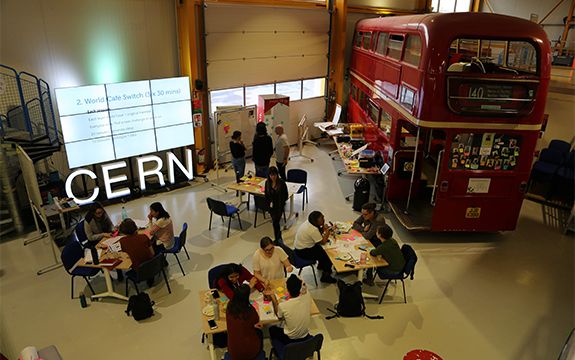The HALO is a conceptual design for an Australian Border Security checkpoint at Melbourne Airport in the year 2030. It combines immigration, customs and declaration into one holistic solution. It manages micro-imaging and scanning of incoming passengers, luggage, cargo and mail, and detects drugs crossing Australian borders via airports. HALO ensures that no human intervention or negligence transpires in monitoring our borders.
HALO is one of three concepts developed by students in 2020 in the Design Factory Melbourne's CBI A3 Program, in partnership with IdeaSquare CERN which builds on earlier Challenge Based Innovation (CBI) focused around using design innovation to develop outcomes that connect CERN technology with societal needs. inno.space Mannheim and the New York City Design Factory joined Design Factory Melbourne to participate in this year's challenge.
 ©
©
Students at CBI A3 'jam' sessions, image by Design Factory Melbourne
The United Nations Sustainable Development Goals provide the framework for the CBI A3 program and guides user-centred research and design to focus on areas of high sustainable impact. The HALO concept is designed for a 2030 world, with bio-screening halos that combine CERN technology and the UN Sustainable Development Goal 3 for Good Health and Wellbeing
The Sustainable Development Goal 3 also targets illicit drugs as one of the pressing problems that are having a negative impact on our health and well-being.
 ©
©
The Halo team at work, image by Design Factory Melbourne
The HALO team from Design Factory Melbourne, are Swinburne University students - Amandeep Singh Narula, Suzi Tzuwei Su and Evan Broumos. They understand drug use is a global problem, with Australia one of the highest users of illicit drugs in the world. With HALO they are focused on preventing drugs from entering the country at airports to help solve the problem.
 ©
©
 ©
©
The HALO team presenting their ideas, image by Design Factory Melbourne
The idea behind the HALO concept starts with disembarking passengers walking directly to a HALO assigned to their flight. They scan their boarding pass or passport to be identified. The passenger then steps into the HALO while their bags are transported on a conveyor belt beside them.
 ©
©
Passengers walking through HALO, image by Narula, Su and Broumos
As each passenger is scanned, the next person begins their identification process. A robotic system is activated for each passenger and places their luggage on a dedicated conveyor belt once the HALO has identified each passenger. With no human intervention in the process, the passenger and their luggage are scanned together and complete the arrival procedure.
It's proposed that the HALO concept is built with CERN technology, resulting in the detection of illicit substances that might be carried by a passenger, hidden in their luggage, in cargo, postal items or even a corrupt officer.
 ©
©
Rough sketch of HALO concept, by Narula, Su and Broumos
The HALO gathers data and compares it to information about illicit drugs through a supervised machine learning capability. The entire process works without human intervention as everything from luggage removal to immigration, customs and declaration, can all be managed by The HALO and robotic technology integration.
Real-time communication provides real-time tracking information of flights and luggage, helping to navigate passenger movement, improving airport service and providing better passenger experience. Research on the identification of illicit drugs, airline and government cooperation, and border protection integration are all key elements.
RFID tags are developed for luggage, cargo and mail to aid robotic detection and identification of items and where they should be relocated at airports. This tracking could also be used by passengers and businesses to track items to prevent loss and tampering.
 ©
©
Exploded view concept drawing of HALO, by Narula, Su and Broumos
This increases passenger experience overall and helps airport authorities better manage the airport during infrastructure redevelopment as the 2030 HALO solution rolls out.
Melbourne Airport is planning a third runway by 2025. By 2030, the HALO team believes management of luggage and passengers will be an even more crucial task to avoid illegal illicit drug importation, and by 2050 HALO, combined with CERN technologies could be installed in airports around the world. HALO also has the potential to play a significant role in the detection of biohazards and assist in controlling pandemics on a global scale.






